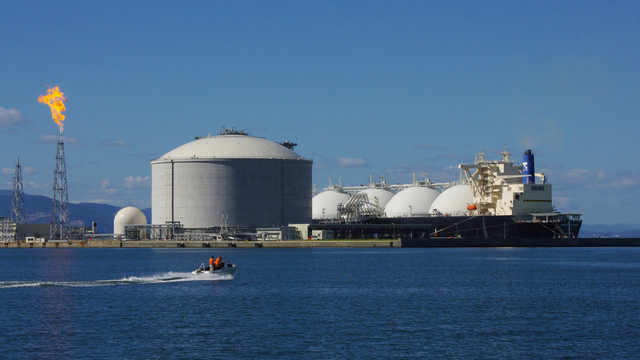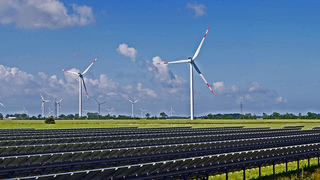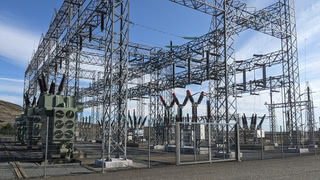Is there a place for E-Methane in a Climate-Neutral Future?
Methane made from green hydrogen and carbon dioxide can directly replace fossil gas. The company TES wants to produce such e-methane, but critics say: that only works due to stacked subsidies and could delay important transformation steps.

In the wake of Russia's invasion of Ukraine in 2022, Germany started building LNG import terminals at multiple locations along the German coasts to replace Russian gas imports. To speed up and incentivize construction, operators of these gas terminals received substantial public funding and favorable exceptions from existing regulations. Initially, these gas import terminals use swimming infrastructure, so-called floating storage and regasification units (FSRUs). It is planned to replace them with stationary terminals on land.
The company Tree Energy Systems (TES) operates one of these LNG terminals in Wilhelmshaven. TES calls its terminal in Wilhelmshaven "Green Energy Hub". However, currently, the project has nothing to do with green energy. It merely imports fossil gas. But TES promises that in the long term, green gas will be imported in Wilhelmshaven — renewable methane made from green hydrogen and carbon dioxide.
Such e-methane, produced in the Sabatier process, is chemically identical to fossil methane, the main component of fossil gas. It is known under different names. TES calls its product E-NG (Electric Natural Gas), other sources use the term SNG (Synthetic Natural Gas), or simply E-Gas.
Using e-methane to store and transport renewable energy is not a new idea. In 2013, the carmaker Audi and the company Kiwi started production of e-methane in a small pilot plant in Germany. However, Kiwi had to declare bankruptcy in 2023. The pilot plant was sold to the company Hy2gen.
Many energy experts and scientists are skeptical about e-methane's role in the energy transition. To understand this better, we need to take a step back and look at hydrogen and its derivatives.
Not everything can be electrified
Renewable energy like solar and wind will almost certainly be the dominant source of energy in the future. In many cases, this will mean direct electrification of processes run by fossil fuels today. Apart from lowering greenhouse gas emissions, this also has benefits like increased efficiency and reduced air pollution.
But not everything can be electrified, even with storage technologies like batteries. Use cases like long-distance aviation and shipping require higher energy densities. In other cases, fossil fuels are used not just as an energy source but also due to their chemical properties. Examples include primary steel production, where cooking coal is used as a reducing agent, or fossil fuels used as a chemical feedstock, like in the production of fertilizers and plastics.
In some of these cases, hydrogen can replace fossil fuels. However, hydrogen also comes with limitations and challenges. It has a low energy density per volume and is difficult to store and transport. In some cases, carbon is simply required as a chemical ingredient. In cases where neither electrification nor hydrogen provides a solution, chemicals made from hydrogen like ammonia or methanol could be used. With such hydrogen derivatives, almost all fossil fuels can be replaced by renewable resources.
E-methane is also a hydrogen derivative, but in recent years, it has not been widely considered as an option. It was assumed that it is almost always better to either use hydrogen directly — which avoids a conversion step — or to use other chemicals like Methanol or Ammonia.
Methane is a gaseous hydrocarbon composed of one carbon and four hydrogen atoms (CH₄). Methanol, a liquid alcohol, also contains one carbon atom and four hydrogen atoms. Additionally, it contains one oxygen atom (CH₃OH). Both chemicals can be made from hydrogen and carbon dioxide.
Green Methanol can achieve higher efficiencies
In terms of thermodynamics, methanol has some advantages compared to methane. As explained here by Paul Martin, due to the chemical reaction, the production of e-methane requires four hydrogen molecules for each methane molecule. The reaction also produces two water molecules as an unneeded by-product. The production of e-methanol requires only three hydrogen molecules for each methanol molecule and produces only one water molecule. In other words, at least under ideal conditions, e-methanol requires less green hydrogen than e-methane. E-methane produces more water as an unneeded by-product and causes more energy losses in the form of heat.
Methanol also has the advantage of being a liquid, which makes handling and storing easier. That completely avoids any concerns about gas leakages. Methane is a potent greenhouse gas. Therefore, any leakage of the gas increases climate warming. (A similar problem exists with pure hydrogen, which is an indirect greenhouse gas.)
Both methane and methanol contain carbon and require a carbon source for their production. It is important to understand that technologies using carbon dioxide as a feedstock, often called Carbon Capture and Utilization (CCU), usually do not permanently avoid emissions. If carbon dioxide from fossil fuels or industrial sources like cement plants is used to make carbon-containing chemicals and those are burned, the embedded carbon is still turned into carbon dioxide and released into the atmosphere.
Therfore, such technologies can use only few carbon dioxide sources in a climate-neutral future. Options are either biogenic carbon dioxide — with some caveats, which we will discuss below — or carbon dioxide directly taken from the air, a technology called direct air capture. The latter is very energy-intensive and expensive.
No carbon, but toxic and dangerous: Ammonia
To avoid the need for climate-friendly carbon dioxide sources, using hydrogen derivatives that do not contain carbon would be attractive. Which brings us to ammonia, a gas already used in large quantities today, mostly to produce fertilizers. Ammonia molecules contain one nitrogen and three hydrogen atoms (NH₃).
Today, almost all ammonia is made from fossil fuels. Ammonia made from green hydrogen has been proposed as a future green shipping fuel or to run power plants in times with low wind and solar output.
Ammonia is also discussed as a potential transport medium for hydrogen. Hydrogen could be converted into ammonia, transported via ship, and converted back into hydrogen in ammonia crackers. Ship transport of ammonia is already an established technology. Yet, the overall efficiency of ammonia as a hydrogen carrier would be quite low, and it raises questions about the future of ammonia production in Europe.
A major challenge with any use of ammonia is safety. The gas is very toxic, and deadly accidents happen regularly. Furthermore, burning ammonia as a fuel can produce NOx and N₂O. NOx gases are air pollutants that cause various health problems. N₂O is itself a potent greenhouse gas.
No hydrogen derivative comes without disadvantages. Therefore, it is wise to only use hydrogen in cases where the alternative of direct electrification is infeasible or impossible. But even considering hard or impossible to electrify sectors, e-methane appears to have little going for it. Using electricity or hydrogen directly is more efficient. If a carbon-containing chemical is required, methanol is often the better alternative. Ammonia avoids the need for a climate-friendly carbon dioxide source and provides a higher energy density than pure hydrogen.
There are also not many cases where methane is required as a chemical feedstock. The main uses of fossil methane feedstock in the chemical industry today are the production of ammonia and methanol. In both cases, it is more efficient to make them directly from hydrogen and avoid an intermediate e-methane step. In rare instances in which methane absolutely cannot be replaced, there is still the option to use biomethane made from biogas.
However, TES and other companies that bet on e-methane think it has one big advantage. It can directly use existing fossil gas infrastructure, which brings us back to the LNG terminal in Wilhelmshaven.
Wilhelmshaven hosts two of multiple new LNG terminals built in Germany to replace Russian gas imports. Many were not happy that new fossil infrastructure was being built in times of a climate crisis.
But the German Federal Ministry for Economic Affairs and Climate Action (BMWK) promised: the new LNG terminals would be "Hydrogen ready". They could be used in the future to import hydrogen or its derivatives. However, the ministry never explained what exactly "Hydrogen ready" means.
There are doubts about the feasibility of using LNG terminals for hydrogen imports. A conversion to liquefied hydrogen, which most experts believe is too inefficient anyway, seems unlikely, as fossil gas and hydrogen are very different gases. A conversion to ammonia is also challenging, although it appears slightly more plausible than a conversion to liquefied hydrogen.
A study by the Fraunhofer ISI research institute concluded: "Currently, it is uncertain if there is a future use case for LNG terminals with renewable energy carriers, which poses a risk for them to become stranded assets in the medium term."
TES came up with the idea that hydrogen could be converted to methane, imported via its LNG terminal, and then reformed back into hydrogen. While this is likely doable, it is not very efficient. It is probably even more inefficient than the ammonia cracking route.
This option would not require any changes at the LNG terminals. Existing LNG carrier ships and pipelines could also be used. Methane is the main component of fossil gas. It can directly be replaced with e-methane. Is that a good option to use LNG terminals for hydrogen imports? Or is it too expensive and inefficient due to the many conversion steps?
Subsidy stacking: IRA, RFNBOs, ETS, and Carbon Contracts
Energy expert Michael Liebreich is a vocal critic of TES. Liebreich, an advisor to energy companies and founder of BloombergNEF, is a well-known voice in the climate and energy debate. In May 2023, Liebreich interviewed Marco Alverà, the CEO of TES, for his podcast Cleaning Up. Liebreich accused Alverà indirectly that he has developed a business model optimized to get as many subsidies as possible.
TES currently plans to build two e-methane production plants in Texas, USA. Under President Biden, the United States enacted the Inflation Reduction Act (IRA) in 2022, a law offering financial subsidies for many clean technologies.
Interestingly, TES CEO Alverà did not deny that his company would benefit from multiple subsidies. In Liebreich's podcast, he said: "There's a lot of money there to be made in layering the different subsidies. So, you get a subsidy for capturing the CO₂, you get a subsidy for producing the renewables, you get a subsidy for producing the hydrogen. And guess what, you can export that molecule, so we we may even be able to get additional subsidies in Europe."
I talked to Jens Schmidt, CTO of TES, about this criticism. According to Schmidt, the subsidies TES gets for hydrogen are comparable to the higher electricity costs TES pays in the United States compared to places more favorable for renewable energy. Also, Schmidt says they do not expect the United States to permanently subsidize exported energy. Furthermore, the subsidies for capturing carbon may even be a disadvantage, but more on that later.
Schmidt further mentions that TES may not use its plants in Texas for gas exports to Germany. The gas could also come from plants in the Middle East or locations within Europe with favorable conditions for renewable energy, like Sweden or Spain.
As Alverà indicated in his quote, TES can likely profit from additional subsidies within the European Union and Germany. The company already has the advantage that its LNG terminal can profit from various favorable regulations enacted due to the Ukraine war.
TES also expects that imported e-methane will be compliant with what the European Union calls Renewable Fuels of Non-Biological Origin (RFNBO). Those RFNBOs include hydrogen and fuels made from hydrogen, energy in chemical carriers, but explicitly not biofuels — those are regulated elsewhere. (RFNBO is a confusing term, as the "Non-Biological Origin" merely refers to the energy content. The carbon content of these renewable fuels can come from biological origins.)
The EU plans quotas for RFNBOs in sectors like air and ship transport and potentially industrial applications. Depending on the carbon source, companies using renewable fuels may also be able to avoid using emission certificates within the European emission trading system — at least according to current plans within the EU.
Potential customers of TES in Germany are hoping to profit from another subsidy. The German government plans to support industries that want to switch to climate-friendly production processes with a system of carbon contracts for difference (Klimaschutzverträge).
The basic idea of these carbon contracts is that companies investing in technologies that substantially reduce emissions but are still more expensive than their fossil competitors will receive payments to compensate for these higher costs. Over time, with expected increases in prices for emission certificates and the maturing of the new technologies, those payments can decline.
In preparation for this support program, companies could submit an expression of interest. The German Federal Ministry for Economic Affairs and Climate Action (BMWK) received fourteen submissions from companies seeking support for using e-methane. The exact number of overall submissions is not public, but this likely means that a significant share of those expressions of interest were e-methane projects. Notably, these companies were seeking support for the direct use of e-methane - not, as the original concept of TES indicated, the use of hydrogen made from imported e-methane.
For industrial companies, using subsidized e-methane is convenient. Many industrial processes are currently powered by fossil gas. Having a drop-in replacement means nothing has to change.
The large number of e-methane projects caused concerns that these projects could outcompete other technologies that are more important and more promising in the long run. It could mean that projects for industrial electrification or the construction of a hydrogen backbone grid will lack the necessary investments.
There are also direct infrastructure conflicts when using either e-methane or hydrogen. Germany plans a hydrogen grid, and while this comes with technical challenges, it may be possible to repurpose some existing gas pipelines for that. Of course, that is only possible if these pipelines are no longer used to transport fossil gas - or e-methane.
The Federal Ministry for Economic Affairs and Climate Action (BMWK) reacted skeptically to the many e-methane applications. The companies expressing their interest in funding received a letter from the ministry suggesting they withdraw their applications.
When asked about e-methane and the carbon contracts, the ministry wrote: "Projects are eligible for funding if the claimed greenhouse gas emission reductions are savings within the meaning of the EU ETS. The current EU ETS legal regime must be applied, and synthetic methane is not currently recognized in the EU ETS." (ETS is the EU's emission trading system.)
According to the BMWK, e-methane projects can only receive funding if the technology is accepted within the EU ETS. However, this is expected to change soon, and e-methane will likely be accepted if it complies with the RFNBO regulation. In background conversations, I heard that while this is the ministry's official stance, it is merely a formality. The real concern is something different.
Is using a drop-in replacement a transformative production process?
The guideline for the German carbon contracts for difference mentions multiple times that the subsidies are supposed to support "transformative production processes". The question is: is it a transformative production process if fossil methane is replaced with e-methane?
For companies seeking to use e-methane, it usually means their technology and production processes don't have to change. They are merely buying e-methane that has already been subsidized elsewhere.
In background conversations, I learned about another concern: the supposed advantage of e-methane - that it could use existing fossil gas infrastructure - could backfire in the long run.
In the beginning, e-methane could use existing gas pipelines, LNG terminals, and other infrastructure from the fossil gas industry. This co-use of fossil gas infrastructure is relatively cheap due to scaling effects. But in the long run, this will change. If climate goals are taken seriously, the use of methane gas will have to decline, even if green alternatives like e-methane or biomethane replace a small part of it.
Effectively, fossil gas infrastructure is cross-subsidizing e-methane. Combined with stacking multiple subsidies, this may create an economic advantage over other alternatives in the short term, but that may not be viable in the long run. It could delay the deployment of more efficient and eventually cheaper alternatives because e-methane takes off the pressure to change.
A study published by the think tank Agora Industry in collaboration with researchers from the Hamburg University of Technology came to a similar conclusion: "Short-term use of existing natural gas grids for transporting SNG could pose a risk to the energy transition if as a result the necessary repurposing of methane pipelines for hydrogen is delayed. In view of their critical importance, the emphasis in Germany should be on conversion to and construction of hydrogen pipelines."
Methane leakages and LNG carriers
A general problem with using methane is that it is itself a greenhouse gas. Therefore, any leakage of methane into the atmosphere causes additional climate warming. The source of the methane — fossil, biogenic, or e-methane — is irrelevant, as they are chemically identical.
In recent years, satellite images, infrared cameras, and better measurement equipment have made it increasingly clear that the gas industry emits much more methane than previously known. Using e-methane — or biomethane — as a climate mitigation technology only makes sense if these methane leakages can be kept very low.
TES plans to import e-methane into Germany with LNG carriers. Liquefied gas has the property that during transport, some of it regasifies. This process is called boil-off. LNG carrier ships usually use this boil-off gas to power their engines. In other words, LNG carriers use part of the LNG they transport as fuel.
LNG was long touted by the shipping industry and even by some environmental NGOs as a cleaner shipping fuel. While it causes less air pollution, methane leakages cause concerns about the climate impact of LNG fuel. For a study published in 2022, researchers measured methane leakage rates on an LNG carrier. Around 3.8 percent of the used boil-off gas escaped into the atmosphere - much more than previously assumed. (The fact that it wasn't until 2022 that such real-world measurements of the supposedly cleaner shipping fuel LNG were done is remarkable on its own.)
Measurements published by a research project from the International Council on Clean Transportation (ICCT) indicate that some types of shipping motors have even higher leakage rates of more than six percent. ICCT also detected methane emissions during LNG cargo unloading, but they were relatively low.
In light of this, it seems obvious that any use of e-methane as a climate solution must consider methane emissions along the whole production and transport chain — and leakages must be kept at very low levels. It seems doubtful whether this is even possible with existing LNG carriers. These results also raise questions about the occasionally proposed possibility of running LNG-powered ships with green methane.
In search of climate-friendly carbon dioxide sources
As indicated earlier, another critical issue for the production of e-methane is the source of carbon dioxide. TES suggests the possibility of a circular process, sometimes also called carbon cycling.
The idea is that at the location where methane is used, carbon dioxide emissions are captured and transported back to the e-methane production facility. It was even proposed that combined LNG and CO₂ carriers ships could transport liquefied methane in one direction and liquefied CO₂ in the other.
However, large-scale carbon dioxide carrier ships are not yet available, though they are being developed for other carbon capture projects. Carrier ships that can switch between methane and carbon dioxide transport are even more speculative and likely not available anytime soon.
Collecting carbon dioxide in such a scenario is also challenging. It may be feasible with the original TES concept that involved reforming methane back into hydrogen near the coast. If e-methane is used decentrally by various industrial companies, capturing carbon dioxide and transporting it back becomes extremely challenging.
It would require transporting CO₂ via a pipeline network in Germany that does not yet exist. Even more challenging, industrial gas combustion processes usually have an extremely low carbon dioxide concentration in their flue gas. Separating carbon dioxide from dilluted flue gas is energy-intensive and expensive.
At least for their early projects, TES does not plan to use carbon cycling and is looking for other carbon dioxide sources. In my conversation with TES-CTO Jens Schmidt, he told me that they plan to use carbon dioxide from a pulp and paper factory for a facility in Canada. For their projects in Texas, they are in negotiations with bioethanol refineries.
Schmidt also explained to me in an e-mail why he thinks that the subsidies in the US for capturing carbon dioxide, known as 45Q credits, do not help TES and may even be a disadvantage. TES does not directly receive these subsidies. They would go to the bioethanol producer that captures the carbon dioxide. Once a company has this capturing infrastructure in place, it could either sell carbon dioxide to off-takers like TES or geologically store it (CCS). It would receive even higher subsidies for the latter. Therefore, buyers of carbon dioxide like TES have to pay more, as this is already priced in.
Carbon dioxide from controversial corn ethanol production
The use of carbon dioxide from bioethanol refineries raises another issue. It is worth taking a step back and asking what climate-friendly or "sustainable" carbon dioxide sources are - not just for e-methane, but for any carbon capture and utilization (CCU) process. One thing is clear: using carbon dioxide from fossil fuels that is later released into the atmosphere is incompatible with a climate-neutral future.
The exact conditions of what constitutes an acceptable carbon dioxide source are currently a controversial question within the EU. Some e-fuel producers like the company HIF (which regular readers of this newsletter may know) are trying to lobby for more relaxed regulations.
Besides direct air capture, carbon dioxide from bioenergy is often named as a potential climate-friendly source for CCU. The naive view, and also the reason why bioenergy is considered climate-friendly in the first place, is that bioenergy only releases carbon that plants have taken from the atmosphere while growing.
However, in reality, things are more complex. The climate footprint of bioenergy crops depends on various factors. Nitrogen fertilizer is almost always made from fossil resources. Some of it (urea) even contains fossil carbon. Fertilizer use also causes N₂O emissions.
Energy crops have substantial impacts on land use. Any land used to grow energy crops cannot be left to nature, which often binds significant amounts of carbon. Conversely, drained peatlands used for agriculture are a substantial source of carbon emissions. Bioenergy crops require large amounts of land. They are effectively a very inefficient way of capturing solar energy. These land use impacts cause significant emissions yet are difficult to quantify.
In the United States, bioethanol from corn - or short corn ethanol - is used in large quantities as a fuel additive. These corn-ethanol-based biofuels are not very favorable for the climate. A study published in 2022 that also considered land use impacts concluded that corn ethanol is worse for the climate than fossil gasoline.
The EU's current plans are that carbon dioxide from biogenic origin is considered a suitable source for green fuels - in EU regulations, they are called RFNBOs or Recycled Carbon Fuels. Regarding biofuels, the EU wants to move towards less damaging sources, e.g., fuels made from biogenic waste.
In light of this, making synthetic fuels and gases with carbon dioxide from the particularly controversial bioethanol production appears questionable. It should be noted, however, that this is not just an issue for e-methane but for any synthetic carbon-containing products like e-fuels or green methanol.
Whether e-methane is a useful solution for climate change remains at least questionable. Ultimately, it could become an expensive solution that no one wants to pay for — and indirectly prolong fossil gas use, because better alternatives have not been developed sooner.
Author: Hanno Böck



